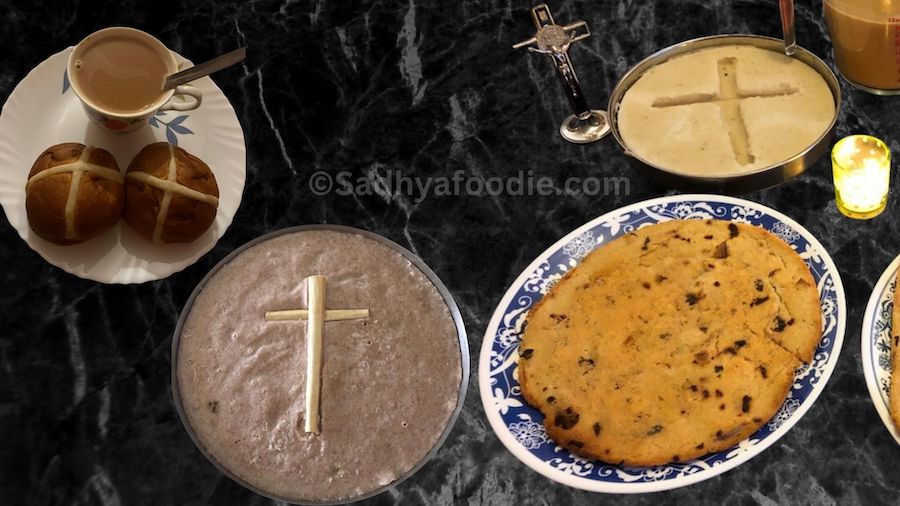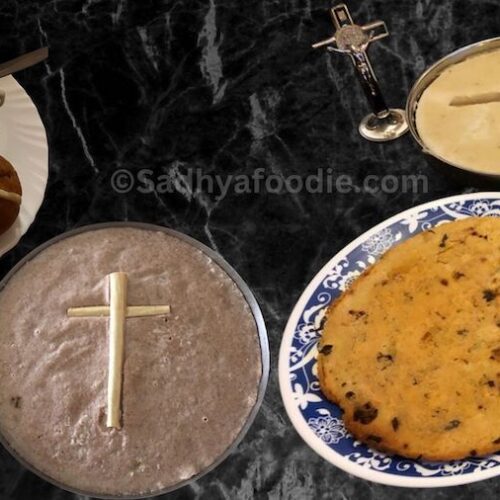How To Make Pesaha Appam / Indri Appam Recipe

Pesaha Appam or Indri Appam is a traditional dish made by Syrian Christians in Kerala, India, especially during Maundy Thursday, the Thursday before Easter. It is a significant part of the Pesaha (Passover) meal, commemorating the Last Supper of Jesus Christ. Pesaha Appam is also known as “Indri Appam” or “Inri Appam,” with “Inri” referring to the Latin acronym for “Jesus of Nazareth, King of the Jews.”
The significance of Pesaha Appam lies in its connection to the Last Supper of Jesus Christ, where unleavened bread (symbolizing purity) and wine were shared among his disciples. In the context of Kerala’s Christian tradition, Pesaha Appam is seen as a symbol of Christ’s body, while the Pesaha Pal or Pesaha Kalkandam symbolizes his blood.
Traditionally, the Pesaha Appam is served with a special accompaniment called “Pesaha Pal” or “Pesaha Kalkandam.” Pesaha Pal is a sweet coconut milk mixture flavored with jaggery.

PESAHA Appam – Indri Appam – Pesaha Pal
Ingredients
For Pesaha Appam
- 1 1/2 cups Raw Rice
- 1/2 cup Urad Dal, washed and dried
- 8-10 Shallots, thinly sliced
- 3/4 cup Coconut pieces
- 4-5 Garlic cloves
- 1 teaspoon Cumin Seeds
- 3/4 cup Grated Coconut
- Salt to taste
- Coconut Oil
- Curry Leaves
- Water as needed
For Pesaha Pal
- 1 cup Brown Sugar
- 1/4 cup Water
- 3 cups Thin Coconut Milk
- 2 tablespoons Rice Flour
- 1/4 teaspoon Cumin Powder
- 1/4 teaspoon Cardamom Powder
- Pinch of Salt
- 1/4 cup Thick Coconut Milk
Instructions
- Wash the raw rice thoroughly 3-4 times, then soak it in water for 30 minutes. After soaking, drain the rice and set aside.
- Heat a pan over medium heat and dry roast the urad dal until it turns light brown. Once done, remove from heat and set aside.
- In the same pan, add a little coconut oil and fry the coconut pieces until they turn golden brown. Remove the coconut from the pan and set aside.
- In the same pan, using the remaining oil, fry the thinly sliced shallots until they become light brown. Once done, remove from the pan and set aside.
- In the same pan, fry the curry leaves until they become crisp. Remove from the pan and set aside, reserving the oil.
- Grind the roasted urad dal into a fine powder.
- Grind the soaked and drained rice into a powder, aiming for a texture similar to rava (semolina).
- In a grinder or blender grind the garlic cloves and cumin seeds with a little water first. Then add grated coconut and crush to form a coarse mixture. Do not grind coconut to paste.
- In a large mixing bowl, combine the ground urad dal powder, ground rice flour, crushed garlic-cumin-coconut mixture, fried shallots, fried coconut pieces, and fried curry leaves. Mix well to combine all the ingredients evenly. Prepare a thick batter with enough water.
- Add salt to taste and mix thoroughly.
Making it on the pan
- Heat some of the reserved oil in a pan. Once hot, pour enough batter into the pan and spread it evenly. Cover the pan and cook the appam over low heat for about 10 minutes or until it is cooked through.
- Remove it from the pan once the appam is cooked and golden brown.
- For a traditional Easter meal, serve the Kerala-style Pesaha Appam hot with Pesaha Pal or Pesaha Kalkandam. Enjoy!
Cooking in Steam
- Grease a round steaming dish, or any other steaming dish, with coconut oil.
- Pour the batter into the greased dish, filling it to about 3/4 full.
- Steam the appam in a steamer for about 20-25 minutes over medium heat, or until a toothpick inserted into the center comes out clean.
- Once cooked, remove the appam from the steamer and allow it to cool slightly before serving.
Prepare Pesaha Pal
- In a large pan, combine 1 cup of brown sugar and 1/4 cup of water. Heat the mixture over medium heat, stirring constantly, until the sugar is completely melted.
- Once the sugar is melted, add 3 cups of thin coconut milk to the pan.
- In a small bowl, mix 2 tablespoons of rice flour with a little water to form a smooth paste, ensuring there are no lumps. Add this rice flour paste to the pan and mix well to incorporate it into the coconut milk mixture.
- Stir the mixture continuously and bring it to a gentle boil.
- Add 1/4 teaspoon of cumin powder, 1/4 teaspoon of cardamom powder, and a pinch of salt to the boiling mixture. Stir well to combine.
- Reduce the heat to low and gradually pour in 1/4 cup of thick coconut milk while stirring continuously. Do not allow the mixture to boil once the thick coconut milk is added.
- Keep stirring until the mixture is heated through. Once hot, turn off the heat.
- Transfer the Pesaha Pal to a serving dish or bowl.
Notes
There are several variations of Pesaha Appam across different regions and households. Here are some of those variations that you will find commonly.
Steamed Pesaha Appam Recipe – Variation #1
Ingredients:
- 2 cups Raw Rice
- 1/2 cup Urad Dal
- 1 1/2 teaspoons Cumin Seeds
- 3-4 cloves Garlic
- 1 cup grated Coconut
- Salt to taste
- Coconut Oil
Instructions:
- Preparation:
- Wash the 2 cups of rice thoroughly several times, then soak them in water for 4-5 hours.
- Dry roast the urad dal in a pan over medium heat until it turns light brown. Remove from heat and set aside.
- Grind the roasted urad dal into powder.
- Grind the soaked rice into powder.
- Prepare Batter:
- In a large mixing bowl, combine the ground urad dal powder, ground rice, crushed garlic-cumin mixture, grated coconut, and salt to taste. Add enough water to make a thick batter.
- Mix the ingredients thoroughly to ensure even distribution.
- Steaming:
- Grease a round steaming dish, or any other steaming dish, with coconut oil.
- Pour the batter into the greased dish, filling it to about 3/4 full.
- Steam the appam in a steamer for about 20-25 minutes over medium heat, or until a toothpick inserted into the center comes out clean.
- Serving:
- Once cooked, remove the appam from the steamer and allow it to cool slightly before serving.
- Serve the Pesaha Appam with Pesaha Pal or Pesaha Kalkandam for a traditional Kerala-style Easter meal.
Enjoy your homemade Pesaha Appam as part of your Easter celebration!
Pesaha Appam with Roasted Rice Flour – Variation #2
Ingredients
- 1 cup Roasted Rice Flour
- 1/4 cup Urad Dal
- 1 cup Grated Coconut
- 4-5 Shallots
- 1 Garlic Clove
- 1 teaspoon Cumin Seeds
- Salt to taste
- Coconut Oil for greasing
Instructions:
- Wash the urad dal thoroughly and soak it in water for about 3-4 hours.
- Drain the soaked urad dal and grind it into a fine paste using a blender or grinder. Transfer the ground urad dal to a mixing bowl.
- In the same blender grind shallots, garlic, and cumin seeds with litter water. Then add grated coconut and crush to a coarse mixture. Do not grind coconut to paste. Add this mixture to the bowl with the ground urad dal.
- Add roasted rice flour and salt into the bowl with the ground urad dal and coconut mixture.
- Mix all the ingredients in the bowl thoroughly to form a thick batter. Add water as needed.
- Grease a round steaming dish, or any other steaming dish, with coconut oil.
- Pour the batter into the greased dish, filling it to about 3/4 full.
- Steam the appam in a steamer for about 20-25 minutes over medium heat, or until a toothpick inserted into the center comes out clean.
- Once cooked, remove the appam from the steamer and allow it to cool slightly before serving.
- Serve the Pesaha Appam with Pesaha Pal or Pesaha Kalkandam for a traditional Kerala-style Easter meal. Enjoy!
Note: If extra smoothness is preferred, you can grind the roasted rice flour with enough water to make a homogeneous consistency before adding in to the mixture.
Pesaha Appam – from Raw Rice & unroasted Urad dal – Variation #3
In this recipe the urad dal is not roasted, it is soaked and ground to a fine paste.
Ingredients:
- 2 cups Rice (Pachari)
- 1 cup Urad Dal
- 1 cup Grated Coconut
- 6-8 Shallots
- 1 teaspoon Cumin Seeds
- 3 Garlic Cloves
- Salt, to taste
- Water, as needed
- Coconut Oil (for brushing)
Instructions:
- Wash the 2 cups of rice thoroughly several times, then soak them in water for 4-5 hours. Also, wash the 1 cup of urad dal several times and soak them in water for 2-3 hours. The ratio of urad dal to rice is 1:2.
- After soaking, grind the soaked urad dal into a fine paste. Transfer the urad dal paste to a mixing bowl.
- Grind the soaked rice into a fine paste as well.
- In a grinder or mixer, coarsely grind the grated coconut, shallots, garlic, and cumin seeds to a coarse consistency, similar to that used for making “thoran.” Do not grind it finely.
- Combine the ground urad dal, ground rice, and the coarse coconut mixture in the mixing bowl. Mix them well together and add salt according to taste. The batter should have the consistency of dosa batter.
- (Optional) Set the batter aside for 30 minutes – 2 hrs to ferment.
- Brush a little coconut oil on a steaming plate to prevent sticking.
- Pour the batter onto the steaming plate, filling it halfway. Make a cross on the surface of the batter.
- Steam the batter in a steamer for about 20 minutes or until it is cooked.
- Once cooked, remove the steamed appam from the steamer and allow it to cool slightly before serving.
Enjoy your Kerala-style Pesaha Appam!
FAQs
The main ingredients for making Pesaha Appam include rice flour, grated coconut, urad dal (black gram lentils), shallots, garlic, cumin seeds, and salt. Some variations may include additional spices or flavorings.
There are recipes with roasted rice flour or you can also make with raw rice. The texture and taste is slightly different but both taste good.
Traditionally pesha appam is made without fermenting the batter. Fermentation can change its flavor and texture. After grinding the batter, allow it to ferment for 2-3 hours. This step is optional but recommended for authentic taste.
Pour the batter into a greased round steaming dish or plate, filling it to about 3/4 full. Steam the appam in a steamer for about 20-25 minutes until cooked through. A toothpick inserted into the center should come out clean when it’s done.
Pesaha Appam is traditionally served with Pesaha Pal or Pesaha Kalkandam, which are sweet coconut milk preparations symbolizing the body and blood of Christ.
While Pesaha Appam is best enjoyed fresh, you can store leftovers in an airtight container in the refrigerator for a day or two. Reheat before serving by steaming or microwaving briefly.
Preheat your oven to 350°F (180°C). Pour the batter into the greased baking dish, spreading it evenly. If using banana leaves, cover the batter with another layer of leaves.
Place the baking dish in the preheated oven and bake for approximately 25-30 minutes or until the appam is cooked through. It should have a golden-brown color on the top and a firm texture.
